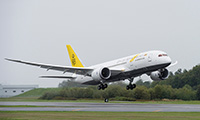News Backgrounder
Go boutique or go bust
Royal Brunei Airlines seeks survival in fierce Southeast Asian market
October 1st 2014
Royal Brunei Airlines, one of the Asia-Pacific’s smaller full-service operators, is reinventing itself as a boutique airline ready to take on legacy rivals and budget airlines alike. However, its management admits big challenges lie ahead. Read More »
The good news, said Karam Chand, chief commercial and planning officer for Royal Brunei Airlines (RBA), is that the airline’s hub sits in the middle of Southeast Asia and its population of 600 million.
 |
| 'When you see US$1 and US$10 fares being dumped on the market every second week, it is really a challenge for full service carriers' |
| Karam Chand Chief commercial and planning officer Royal Brunei Airlines |
But “we are bordered by premium carriers such as Singapore Airlines and Thai Airways International, as well as being surrounded by the largest low-cost carriers in the world”, he said. It is, Chand concedes, an interesting challenge for his carrier.
But it is one said the Fiji-born Australian and former senior executive with budget carrier, Virgin Blue, the airline is meeting head on. After a woeful period following the Global Financial Crisis (GFC), when RBA closed routes and cut staff, it has rebuilt and recently added to its prestige by becoming the first carrier in Southeast Asia to operate the B787 Dreamliner.
“We had a perfect storm some years ago, as so many other carriers did after the GFC as demand collapsed and then fuel prices hit, and maintained, new highs,” said Chand.
“We are 40 years old. As you get older you start to show signs of age. You become high maintenance. You have problems with communications. You become extremely conservative. Given the GFC and the fuel situation we had no choice but to make some tough decisions.”
They included drastic surgery in 2011, with the elimination of flights to Auckland, New Zealand, Brisbane and Perth in Australia, Ho Chi Minh City, Viet Nam and Kuching in Malaysia.
“We also had to start right-sizing. At one time, we had 2,000 staff with less than nine planes. We had to become staff right-sized for our longer term strategy. We also had to simplify our fleet to reduce operating costs. We are small, but we have a very supportive shareholder who saw merit in taking on our rebuilding,” he said.
The result was an order for five B787s, four of which are in service with the fifth scheduled to arrive in 2018. Currently operating two A319-100s and four A320-200s, RBA has also ordered seven A320neos which will begin arriving in 2018. Built into these orders is an ability to scale up or scale down to match market demand. “That is paramount. For us, it is very fundamental to meet market demand rather than growing capacity ahead of demand,” said Chand.
 |
The Dreamliners are flying on long-haul routes to Jeddah, Saudi Arabia and from Melbourne to Brunei, then on to Dubai and London. Regionally, RBA operates A320s to Shanghai, Hong Kong, Manila, Kota Kinabalu, Bangkok, Kuala Lumpur, Singapore, Indonesia’s Jakarta, Surabaya and Bali, and Ho Chi Minh City from this month.
The Dreamliners are making a difference, said Chand. “You can’t do much about the fuel price, but what you can have are fuel efficient aircraft. Our 787’s round trip from Melbourne to London saves 100,000 litres of fuel and if you know the fuel price that’s a lot of savings. The A320neos give us advantages on regional routes. We think we will see a 18% to 20% reduction in our fuel costs. That’s a fantastic outcome for an airline of our size.”
The new RBA is not only about new aircraft. It is about a transformation of an ageing legacy carrier into a boutique airline. “We had to go through a rebranding exercise to make sure people saw us in a different light,” explained Chand.
“One of the first tasks was to establish ourselves as a boutique airline in Southeast Asia. What does that mean? We don’t have the network of the big guys. We don’t have the cost structure of AirAsia X. We also - and this is probably not widely known - are based in a country where the manpower costs are much higher than in the Philippines, Indonesia or even North Asia.
“That impacts our cost base. It’s higher than those guys so we had to focus on service. We contracted a company that had helped Singapore Airlines (SIA) establish their highest standards of training and we went through a very significant program with senior management to change the mindset and introduce [greater] customer focus.
“All staff have gone through mindset and service training and we have invested in systems and processes to support customer service.”
Chand said the theme is “warmth”. “That means warmth from our staff. We are attending to our customers’ needs. We are reliable, safe and are innovative. We need to be consistent and we need to resolve customers’ problems and make sure they have a pleasant experience," he said.
“There is no way we can duplicate the SIA network. There’s no way we can get AirAsia’s cost structure. The only place we can make a difference is the service side with customer focus. ‘Wow that was something different’.”
One of RBA’s major challenges is the size of its home market. Brunei has a population of 400,000 although its GDP per capita is the fifth highest in the world, primarily because a major part of its economy is crude oil and gas.
As a result, RBA relies on transit passengers for more than 60% of its business and these days it has a lot of competition. “Everybody wants to lower costs. Revenue is being driven by the low-cost guys and by Gulf carriers operating long-haul with huge capacity. Both these factors are driving down fares,” said Chand.
“So if your revenue is outside your control, it is fundamental that we have focus on reducing the fuel burn cost.”
The next imminent “interesting dilemma and challenge is the arrival of Asean open skies on January 1 next year. It will open up capacity in all the Asean countries and, of course, it opens up capacity to Brunei for competitors", he said.
Even before the arrival of open skies, capacity dumping by low-cost carriers has become an issue. “When you see $1 and $10 fares being offered in the market every second week it is a real challenge for full service carriers. Our cost structures are simply not there. This is something we are discussing with different governments. We want Brunei, as an example, to exercise its rights under the air fares agreement and deal with what we call predatory behavior,” he said.
The airline has also been innovative on the freight front, last year contracting with a UK company, Air Logistics, to handle all its belly space. “We felt giving it to someone who really knows the freight business was the way to go. Every month we get a cheque, which is a very important outcome for us,” he said.
“There are no delays in Brunei and we are promoting it as a hub. Air Logistics are able to give us global coverage and revenue manage our cargo, which a lot of small companies can’t do.”
RBA does not intend to significantly increase its long-haul flying but will continue to focus on expanding its regional markets. For example, the arrival of the A320neos, with their longer range, will open up opportunities for the carrier in North Asia and the Indian subcontinent.
“These are markets we will look at as these aircraft get closer to delivery. We will focus on short to medium haul regional flying and aspire to serve all the key Asean cities with a minimum daily service,” Chand said.
Competition will be fierce. Chand pointed out that 27% of region’s routes are served by at least five airlines of all models, compared with Europe where 45% of routes are served by just one or two airlines. “You can see how competitive it has become. It is inevitable that the LCCs will end up completely dominating these markets. But we feel, as a boutique airline and one aspiring to be a very strong boutique airline,that the model will do very well by offering a unique, high quality service that is relevant to the market.”
| The threat of open skies “I pose this question to our competitors: Are they going to mount capacity based on sustainable economics or will they just place aircraft because they’ve got thousands of aircraft coming over the next several years?” asked Chand. “It’s a multi-million dollar question for us. It’s a very important challenge for small airlines around the region. What do you do under these policy settings? You can have open skies, but open skies leads to capacity dumping and irrational pricing and that’s not the best outcome you want.” |